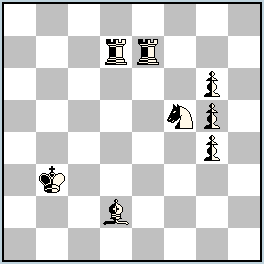|
No.516 |
Original Problems, Julia’s Fairies – 2014 (I): January – April →Previous ; →Next ; →List 2014(I) Please send your original fairy problems to: julia@juliasfairies.com |
No.516 by Igor Kochulov – Duplex in Take&Make problem composed with neutral pieces only! (JV)
Definitions:
Take & Make: Having captured, a unit must immediately, as part of its move, play a non-capturing move in imitation of the captured unit from the capture-square. If no such move is available, the capture is illegal. Promotion by capture occurs only when a pawn arrives on the promotion rank as the result of a take&make move. Checks are as in normal chess: after the notional capture of the checked K, the checking unit does not move away from the King’s square.
|
No.516 Igor Kochulov
Russia
original – 12.03.2014
 hs#2 duplex (0+0+8) hs#2 duplex (0+0+8)Take&Make Solutions: (click to show/hide)
|



Very interesting solutions with mate by the same pawn! I have not seen many neutral King and the possibilities are perhaps unexplored. It is nice to see that the Russian composers are so very talented in Fairy Chess which was officially banned there not many years ago (in the 80s?).
The only neutral piece that can mate a neutral king is a pawn, because any other piece would give self-check! I like the moves 1.nBc3 and 1.nKc2, which each allow the nK to capture the nB. In each solution the nPg5 makes the final check and then the mate (the moves 2.nKxc3-f6+ and 2.nKxd2-f4+ are both checks, but that was not indicated in the solutions below the diagram). Each piece is needed in each solution, which is rare in a duplex. In the first solution the nPg4 prevents 2…g5-g4, while in the second solution the nPg6 prevents 2…g5-g6.
The moves 1…Re3 and 1…Rd3 are very interesting. In the first solution, after 1.Bc3 Rd3? 2.Kxc3-f6+, the nK could escape with e.g. 2…Kxe7-a7! In the second solution, after 1.Kc2 Re3?, the nRe3 prevents the nK “making” to f4, which is a bit of a pity, because a nKf4 could still escape with e.g. 2…Kxe3-a3!
I found it confusing to have all neutral pieces in a duplex. I had to keep reminding myself which side was making each move!
Really a very interesting problem. The author should be praised for such a beautiful imagination of having all pieces as neutral pieces. The play is very harmonious. As Geoff mentioned, both 2.nKxc3-f6 & 2.nKxd2-f4 must be checks. It is interesting to note that these checks are not self checks.
Sorry, solutions are corrected: checks added to 2.nKxc3-f6 & 2.nKxd2-f4.
It looks nice and interesting. Still, the facts could be analyzed to see what makes the impression.
-…Each piece is needed in each solution, which is rare in a duplex…-
The point of a true duplex is exactly a balanced thematic use of all pieces in all phases. Duplex is not just any mating of bK and wK from the same position.
The same author has presented the beautiful No.377 with an extraordinary change of pieces’ functions in ODT. That is a true duplex.
Helpselfmates seem particularly suitable for duplex, only a detail decides which King will be mated. For instance:
W:Kh1,Bh2,Qc4; B:Ka8,Ba7,Qf5; s#1,duplex
1.Qd5+/1.Qe4+
This is repeating of the same content, without any change. The reason for composing two or more phases is showing some interesting change or transformation.
No.516 is interesting because there’s only one King but mated both by Black and White. However, the essence is only partially changed in 2 phases. The changed way of selfcheck avoidance determines the order of moves (1.Rc3++?/1.Rd3++?). The mentioned dual-avoidance 1…Rc3(Rd3?)/1…Rd3(Rc3?) is not pure but the 1st half of the solutions do show some changes.
The last 2 halfmoves would in principle spoil a charm of duplex but there is the main point of the problem, one half of nK is forced to lead the other half into mate. Is it worth repeating in the other phase of a duplex without any change? Here it is very amusing, the same nPg5 check(mate)s nK on 4 squares. Such thematic intensity in one focus is a convincing reason.
A “perfect” analogy could be a failure:
W: Pg4; B: Pg6; Neut: Rd7,Sc5,Ke5,Sf5,Pg5,Rd3
Hs#2, T&M, duplex
BTW, bPg6/wPg4 would work fine also in the original.